Tax Implications on Oasis Family Trust, Goodlook Ltd and Milo Ltd
VerifiedAdded on 2023/06/09
|8
|3224
|198
AI Summary
This article discusses the tax implications on Oasis Family Trust, Goodlook Ltd and Milo Ltd in various scenarios such as forgiven debt, prepayments, fringe benefits, and interest-free loans. It explains the reasoning behind each conclusion and cites relevant sections of the New Zealand Income Tax Act, 2007. The article covers subjects such as Advanced Taxation, FBT, and dividend implications. The course code, course name, and college/university are not mentioned.
Contribute Materials
Your contribution can guide someone’s learning journey. Share your
documents today.
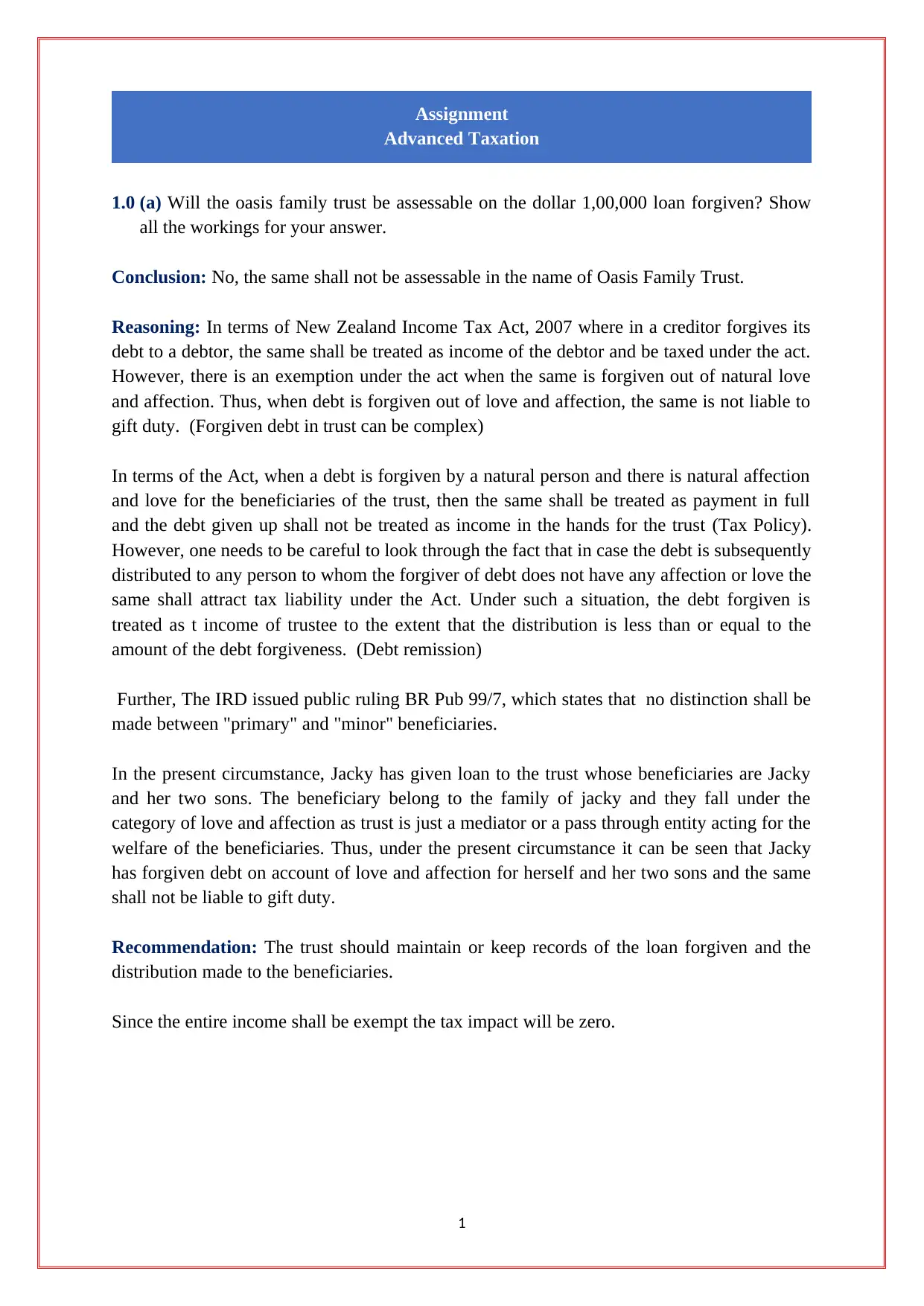
Assignment
Advanced Taxation
1.0 (a) Will the oasis family trust be assessable on the dollar 1,00,000 loan forgiven? Show
all the workings for your answer.
Conclusion: No, the same shall not be assessable in the name of Oasis Family Trust.
Reasoning: In terms of New Zealand Income Tax Act, 2007 where in a creditor forgives its
debt to a debtor, the same shall be treated as income of the debtor and be taxed under the act.
However, there is an exemption under the act when the same is forgiven out of natural love
and affection. Thus, when debt is forgiven out of love and affection, the same is not liable to
gift duty. (Forgiven debt in trust can be complex)
In terms of the Act, when a debt is forgiven by a natural person and there is natural affection
and love for the beneficiaries of the trust, then the same shall be treated as payment in full
and the debt given up shall not be treated as income in the hands for the trust (Tax Policy).
However, one needs to be careful to look through the fact that in case the debt is subsequently
distributed to any person to whom the forgiver of debt does not have any affection or love the
same shall attract tax liability under the Act. Under such a situation, the debt forgiven is
treated as t income of trustee to the extent that the distribution is less than or equal to the
amount of the debt forgiveness. (Debt remission)
Further, The IRD issued public ruling BR Pub 99/7, which states that no distinction shall be
made between "primary" and "minor" beneficiaries.
In the present circumstance, Jacky has given loan to the trust whose beneficiaries are Jacky
and her two sons. The beneficiary belong to the family of jacky and they fall under the
category of love and affection as trust is just a mediator or a pass through entity acting for the
welfare of the beneficiaries. Thus, under the present circumstance it can be seen that Jacky
has forgiven debt on account of love and affection for herself and her two sons and the same
shall not be liable to gift duty.
Recommendation: The trust should maintain or keep records of the loan forgiven and the
distribution made to the beneficiaries.
Since the entire income shall be exempt the tax impact will be zero.
1
Advanced Taxation
1.0 (a) Will the oasis family trust be assessable on the dollar 1,00,000 loan forgiven? Show
all the workings for your answer.
Conclusion: No, the same shall not be assessable in the name of Oasis Family Trust.
Reasoning: In terms of New Zealand Income Tax Act, 2007 where in a creditor forgives its
debt to a debtor, the same shall be treated as income of the debtor and be taxed under the act.
However, there is an exemption under the act when the same is forgiven out of natural love
and affection. Thus, when debt is forgiven out of love and affection, the same is not liable to
gift duty. (Forgiven debt in trust can be complex)
In terms of the Act, when a debt is forgiven by a natural person and there is natural affection
and love for the beneficiaries of the trust, then the same shall be treated as payment in full
and the debt given up shall not be treated as income in the hands for the trust (Tax Policy).
However, one needs to be careful to look through the fact that in case the debt is subsequently
distributed to any person to whom the forgiver of debt does not have any affection or love the
same shall attract tax liability under the Act. Under such a situation, the debt forgiven is
treated as t income of trustee to the extent that the distribution is less than or equal to the
amount of the debt forgiveness. (Debt remission)
Further, The IRD issued public ruling BR Pub 99/7, which states that no distinction shall be
made between "primary" and "minor" beneficiaries.
In the present circumstance, Jacky has given loan to the trust whose beneficiaries are Jacky
and her two sons. The beneficiary belong to the family of jacky and they fall under the
category of love and affection as trust is just a mediator or a pass through entity acting for the
welfare of the beneficiaries. Thus, under the present circumstance it can be seen that Jacky
has forgiven debt on account of love and affection for herself and her two sons and the same
shall not be liable to gift duty.
Recommendation: The trust should maintain or keep records of the loan forgiven and the
distribution made to the beneficiaries.
Since the entire income shall be exempt the tax impact will be zero.
1
Secure Best Marks with AI Grader
Need help grading? Try our AI Grader for instant feedback on your assignments.
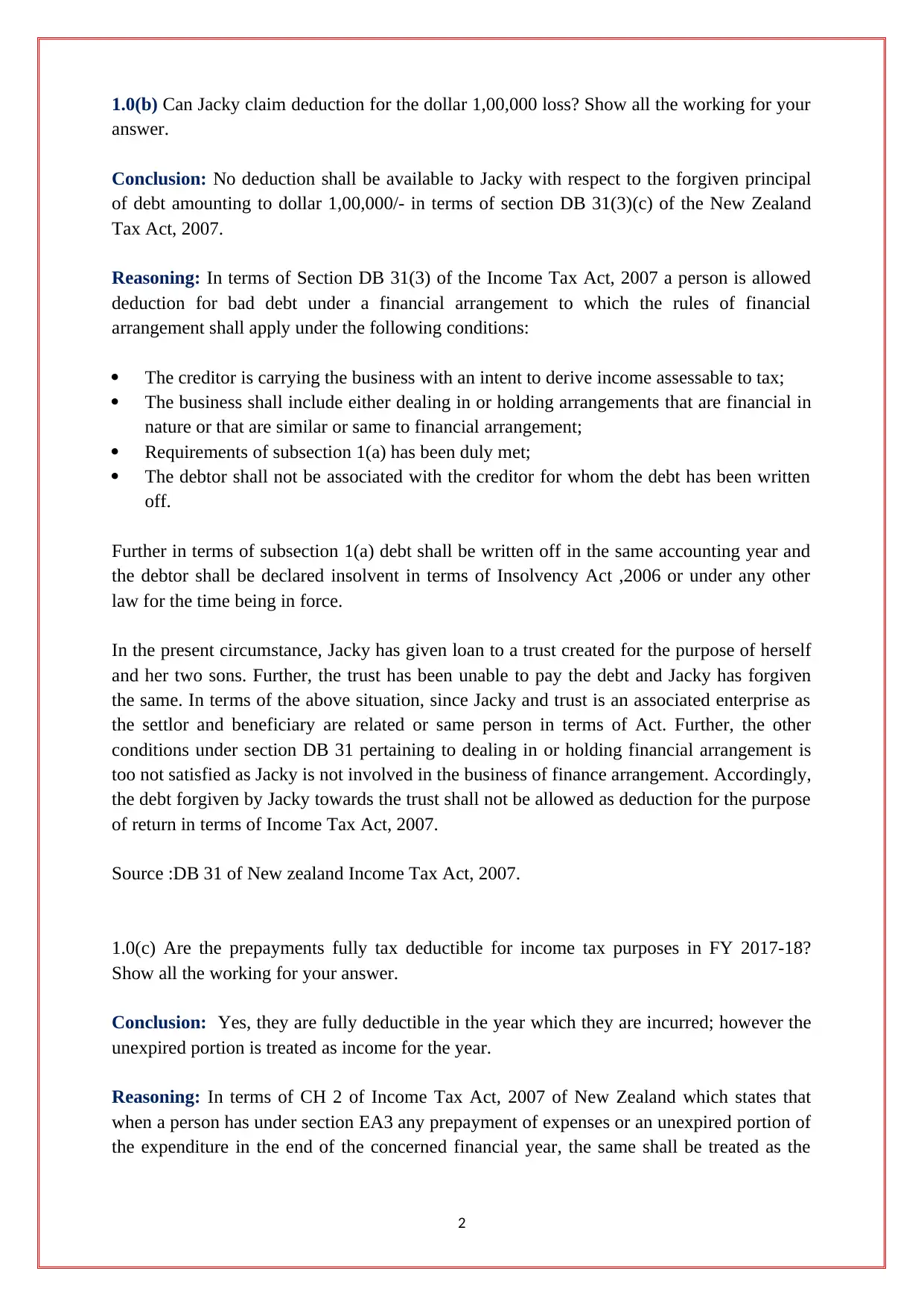
1.0(b) Can Jacky claim deduction for the dollar 1,00,000 loss? Show all the working for your
answer.
Conclusion: No deduction shall be available to Jacky with respect to the forgiven principal
of debt amounting to dollar 1,00,000/- in terms of section DB 31(3)(c) of the New Zealand
Tax Act, 2007.
Reasoning: In terms of Section DB 31(3) of the Income Tax Act, 2007 a person is allowed
deduction for bad debt under a financial arrangement to which the rules of financial
arrangement shall apply under the following conditions:
The creditor is carrying the business with an intent to derive income assessable to tax;
The business shall include either dealing in or holding arrangements that are financial in
nature or that are similar or same to financial arrangement;
Requirements of subsection 1(a) has been duly met;
The debtor shall not be associated with the creditor for whom the debt has been written
off.
Further in terms of subsection 1(a) debt shall be written off in the same accounting year and
the debtor shall be declared insolvent in terms of Insolvency Act ,2006 or under any other
law for the time being in force.
In the present circumstance, Jacky has given loan to a trust created for the purpose of herself
and her two sons. Further, the trust has been unable to pay the debt and Jacky has forgiven
the same. In terms of the above situation, since Jacky and trust is an associated enterprise as
the settlor and beneficiary are related or same person in terms of Act. Further, the other
conditions under section DB 31 pertaining to dealing in or holding financial arrangement is
too not satisfied as Jacky is not involved in the business of finance arrangement. Accordingly,
the debt forgiven by Jacky towards the trust shall not be allowed as deduction for the purpose
of return in terms of Income Tax Act, 2007.
Source :DB 31 of New zealand Income Tax Act, 2007.
1.0(c) Are the prepayments fully tax deductible for income tax purposes in FY 2017-18?
Show all the working for your answer.
Conclusion: Yes, they are fully deductible in the year which they are incurred; however the
unexpired portion is treated as income for the year.
Reasoning: In terms of CH 2 of Income Tax Act, 2007 of New Zealand which states that
when a person has under section EA3 any prepayment of expenses or an unexpired portion of
the expenditure in the end of the concerned financial year, the same shall be treated as the
2
answer.
Conclusion: No deduction shall be available to Jacky with respect to the forgiven principal
of debt amounting to dollar 1,00,000/- in terms of section DB 31(3)(c) of the New Zealand
Tax Act, 2007.
Reasoning: In terms of Section DB 31(3) of the Income Tax Act, 2007 a person is allowed
deduction for bad debt under a financial arrangement to which the rules of financial
arrangement shall apply under the following conditions:
The creditor is carrying the business with an intent to derive income assessable to tax;
The business shall include either dealing in or holding arrangements that are financial in
nature or that are similar or same to financial arrangement;
Requirements of subsection 1(a) has been duly met;
The debtor shall not be associated with the creditor for whom the debt has been written
off.
Further in terms of subsection 1(a) debt shall be written off in the same accounting year and
the debtor shall be declared insolvent in terms of Insolvency Act ,2006 or under any other
law for the time being in force.
In the present circumstance, Jacky has given loan to a trust created for the purpose of herself
and her two sons. Further, the trust has been unable to pay the debt and Jacky has forgiven
the same. In terms of the above situation, since Jacky and trust is an associated enterprise as
the settlor and beneficiary are related or same person in terms of Act. Further, the other
conditions under section DB 31 pertaining to dealing in or holding financial arrangement is
too not satisfied as Jacky is not involved in the business of finance arrangement. Accordingly,
the debt forgiven by Jacky towards the trust shall not be allowed as deduction for the purpose
of return in terms of Income Tax Act, 2007.
Source :DB 31 of New zealand Income Tax Act, 2007.
1.0(c) Are the prepayments fully tax deductible for income tax purposes in FY 2017-18?
Show all the working for your answer.
Conclusion: Yes, they are fully deductible in the year which they are incurred; however the
unexpired portion is treated as income for the year.
Reasoning: In terms of CH 2 of Income Tax Act, 2007 of New Zealand which states that
when a person has under section EA3 any prepayment of expenses or an unexpired portion of
the expenditure in the end of the concerned financial year, the same shall be treated as the
2
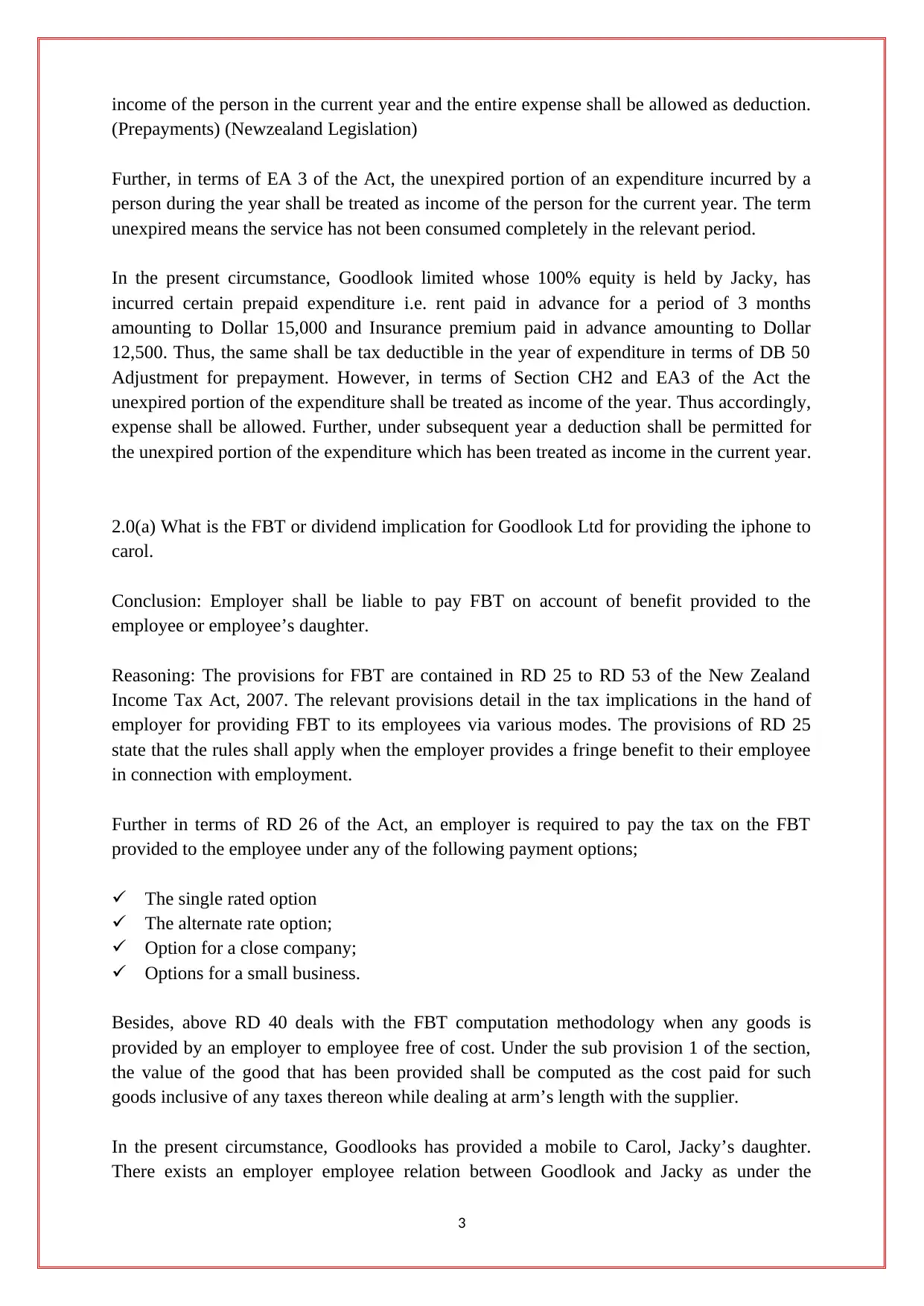
income of the person in the current year and the entire expense shall be allowed as deduction.
(Prepayments) (Newzealand Legislation)
Further, in terms of EA 3 of the Act, the unexpired portion of an expenditure incurred by a
person during the year shall be treated as income of the person for the current year. The term
unexpired means the service has not been consumed completely in the relevant period.
In the present circumstance, Goodlook limited whose 100% equity is held by Jacky, has
incurred certain prepaid expenditure i.e. rent paid in advance for a period of 3 months
amounting to Dollar 15,000 and Insurance premium paid in advance amounting to Dollar
12,500. Thus, the same shall be tax deductible in the year of expenditure in terms of DB 50
Adjustment for prepayment. However, in terms of Section CH2 and EA3 of the Act the
unexpired portion of the expenditure shall be treated as income of the year. Thus accordingly,
expense shall be allowed. Further, under subsequent year a deduction shall be permitted for
the unexpired portion of the expenditure which has been treated as income in the current year.
2.0(a) What is the FBT or dividend implication for Goodlook Ltd for providing the iphone to
carol.
Conclusion: Employer shall be liable to pay FBT on account of benefit provided to the
employee or employee’s daughter.
Reasoning: The provisions for FBT are contained in RD 25 to RD 53 of the New Zealand
Income Tax Act, 2007. The relevant provisions detail in the tax implications in the hand of
employer for providing FBT to its employees via various modes. The provisions of RD 25
state that the rules shall apply when the employer provides a fringe benefit to their employee
in connection with employment.
Further in terms of RD 26 of the Act, an employer is required to pay the tax on the FBT
provided to the employee under any of the following payment options;
The single rated option
The alternate rate option;
Option for a close company;
Options for a small business.
Besides, above RD 40 deals with the FBT computation methodology when any goods is
provided by an employer to employee free of cost. Under the sub provision 1 of the section,
the value of the good that has been provided shall be computed as the cost paid for such
goods inclusive of any taxes thereon while dealing at arm’s length with the supplier.
In the present circumstance, Goodlooks has provided a mobile to Carol, Jacky’s daughter.
There exists an employer employee relation between Goodlook and Jacky as under the
3
(Prepayments) (Newzealand Legislation)
Further, in terms of EA 3 of the Act, the unexpired portion of an expenditure incurred by a
person during the year shall be treated as income of the person for the current year. The term
unexpired means the service has not been consumed completely in the relevant period.
In the present circumstance, Goodlook limited whose 100% equity is held by Jacky, has
incurred certain prepaid expenditure i.e. rent paid in advance for a period of 3 months
amounting to Dollar 15,000 and Insurance premium paid in advance amounting to Dollar
12,500. Thus, the same shall be tax deductible in the year of expenditure in terms of DB 50
Adjustment for prepayment. However, in terms of Section CH2 and EA3 of the Act the
unexpired portion of the expenditure shall be treated as income of the year. Thus accordingly,
expense shall be allowed. Further, under subsequent year a deduction shall be permitted for
the unexpired portion of the expenditure which has been treated as income in the current year.
2.0(a) What is the FBT or dividend implication for Goodlook Ltd for providing the iphone to
carol.
Conclusion: Employer shall be liable to pay FBT on account of benefit provided to the
employee or employee’s daughter.
Reasoning: The provisions for FBT are contained in RD 25 to RD 53 of the New Zealand
Income Tax Act, 2007. The relevant provisions detail in the tax implications in the hand of
employer for providing FBT to its employees via various modes. The provisions of RD 25
state that the rules shall apply when the employer provides a fringe benefit to their employee
in connection with employment.
Further in terms of RD 26 of the Act, an employer is required to pay the tax on the FBT
provided to the employee under any of the following payment options;
The single rated option
The alternate rate option;
Option for a close company;
Options for a small business.
Besides, above RD 40 deals with the FBT computation methodology when any goods is
provided by an employer to employee free of cost. Under the sub provision 1 of the section,
the value of the good that has been provided shall be computed as the cost paid for such
goods inclusive of any taxes thereon while dealing at arm’s length with the supplier.
In the present circumstance, Goodlooks has provided a mobile to Carol, Jacky’s daughter.
There exists an employer employee relation between Goodlook and Jacky as under the
3
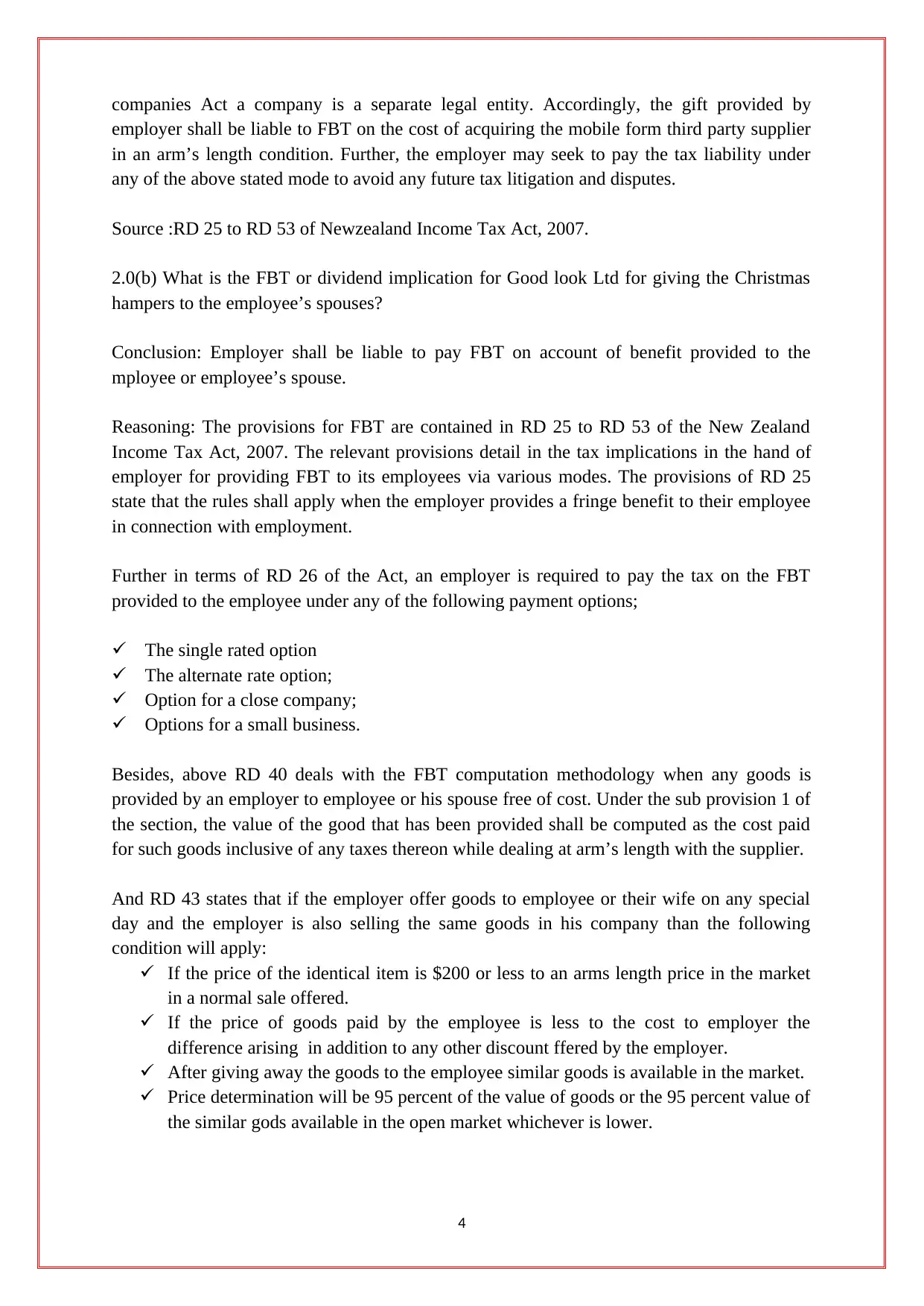
companies Act a company is a separate legal entity. Accordingly, the gift provided by
employer shall be liable to FBT on the cost of acquiring the mobile form third party supplier
in an arm’s length condition. Further, the employer may seek to pay the tax liability under
any of the above stated mode to avoid any future tax litigation and disputes.
Source :RD 25 to RD 53 of Newzealand Income Tax Act, 2007.
2.0(b) What is the FBT or dividend implication for Good look Ltd for giving the Christmas
hampers to the employee’s spouses?
Conclusion: Employer shall be liable to pay FBT on account of benefit provided to the
mployee or employee’s spouse.
Reasoning: The provisions for FBT are contained in RD 25 to RD 53 of the New Zealand
Income Tax Act, 2007. The relevant provisions detail in the tax implications in the hand of
employer for providing FBT to its employees via various modes. The provisions of RD 25
state that the rules shall apply when the employer provides a fringe benefit to their employee
in connection with employment.
Further in terms of RD 26 of the Act, an employer is required to pay the tax on the FBT
provided to the employee under any of the following payment options;
The single rated option
The alternate rate option;
Option for a close company;
Options for a small business.
Besides, above RD 40 deals with the FBT computation methodology when any goods is
provided by an employer to employee or his spouse free of cost. Under the sub provision 1 of
the section, the value of the good that has been provided shall be computed as the cost paid
for such goods inclusive of any taxes thereon while dealing at arm’s length with the supplier.
And RD 43 states that if the employer offer goods to employee or their wife on any special
day and the employer is also selling the same goods in his company than the following
condition will apply:
If the price of the identical item is $200 or less to an arms length price in the market
in a normal sale offered.
If the price of goods paid by the employee is less to the cost to employer the
difference arising in addition to any other discount ffered by the employer.
After giving away the goods to the employee similar goods is available in the market.
Price determination will be 95 percent of the value of goods or the 95 percent value of
the similar gods available in the open market whichever is lower.
4
employer shall be liable to FBT on the cost of acquiring the mobile form third party supplier
in an arm’s length condition. Further, the employer may seek to pay the tax liability under
any of the above stated mode to avoid any future tax litigation and disputes.
Source :RD 25 to RD 53 of Newzealand Income Tax Act, 2007.
2.0(b) What is the FBT or dividend implication for Good look Ltd for giving the Christmas
hampers to the employee’s spouses?
Conclusion: Employer shall be liable to pay FBT on account of benefit provided to the
mployee or employee’s spouse.
Reasoning: The provisions for FBT are contained in RD 25 to RD 53 of the New Zealand
Income Tax Act, 2007. The relevant provisions detail in the tax implications in the hand of
employer for providing FBT to its employees via various modes. The provisions of RD 25
state that the rules shall apply when the employer provides a fringe benefit to their employee
in connection with employment.
Further in terms of RD 26 of the Act, an employer is required to pay the tax on the FBT
provided to the employee under any of the following payment options;
The single rated option
The alternate rate option;
Option for a close company;
Options for a small business.
Besides, above RD 40 deals with the FBT computation methodology when any goods is
provided by an employer to employee or his spouse free of cost. Under the sub provision 1 of
the section, the value of the good that has been provided shall be computed as the cost paid
for such goods inclusive of any taxes thereon while dealing at arm’s length with the supplier.
And RD 43 states that if the employer offer goods to employee or their wife on any special
day and the employer is also selling the same goods in his company than the following
condition will apply:
If the price of the identical item is $200 or less to an arms length price in the market
in a normal sale offered.
If the price of goods paid by the employee is less to the cost to employer the
difference arising in addition to any other discount ffered by the employer.
After giving away the goods to the employee similar goods is available in the market.
Price determination will be 95 percent of the value of goods or the 95 percent value of
the similar gods available in the open market whichever is lower.
4
Secure Best Marks with AI Grader
Need help grading? Try our AI Grader for instant feedback on your assignments.
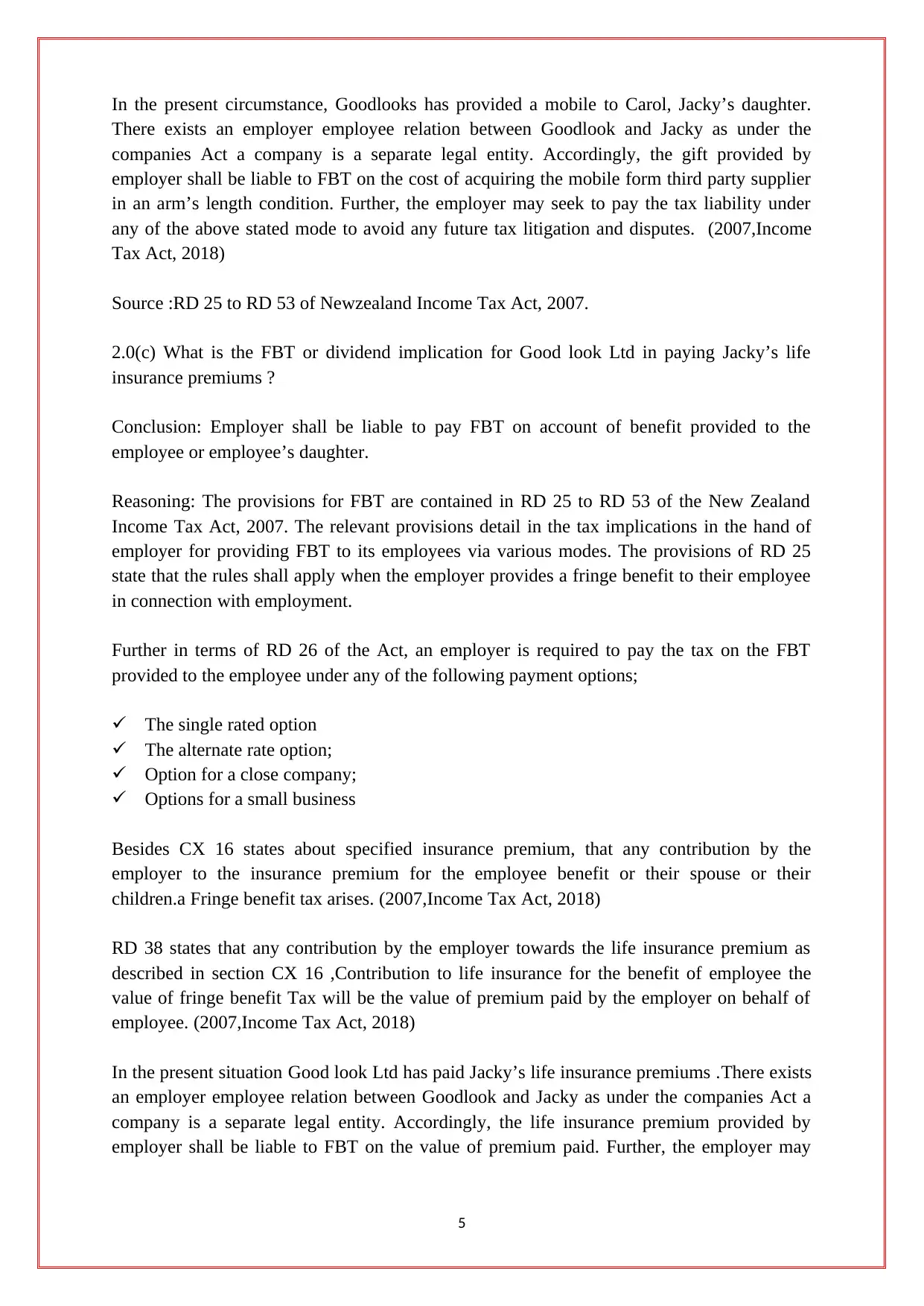
In the present circumstance, Goodlooks has provided a mobile to Carol, Jacky’s daughter.
There exists an employer employee relation between Goodlook and Jacky as under the
companies Act a company is a separate legal entity. Accordingly, the gift provided by
employer shall be liable to FBT on the cost of acquiring the mobile form third party supplier
in an arm’s length condition. Further, the employer may seek to pay the tax liability under
any of the above stated mode to avoid any future tax litigation and disputes. (2007,Income
Tax Act, 2018)
Source :RD 25 to RD 53 of Newzealand Income Tax Act, 2007.
2.0(c) What is the FBT or dividend implication for Good look Ltd in paying Jacky’s life
insurance premiums ?
Conclusion: Employer shall be liable to pay FBT on account of benefit provided to the
employee or employee’s daughter.
Reasoning: The provisions for FBT are contained in RD 25 to RD 53 of the New Zealand
Income Tax Act, 2007. The relevant provisions detail in the tax implications in the hand of
employer for providing FBT to its employees via various modes. The provisions of RD 25
state that the rules shall apply when the employer provides a fringe benefit to their employee
in connection with employment.
Further in terms of RD 26 of the Act, an employer is required to pay the tax on the FBT
provided to the employee under any of the following payment options;
The single rated option
The alternate rate option;
Option for a close company;
Options for a small business
Besides CX 16 states about specified insurance premium, that any contribution by the
employer to the insurance premium for the employee benefit or their spouse or their
children.a Fringe benefit tax arises. (2007,Income Tax Act, 2018)
RD 38 states that any contribution by the employer towards the life insurance premium as
described in section CX 16 ,Contribution to life insurance for the benefit of employee the
value of fringe benefit Tax will be the value of premium paid by the employer on behalf of
employee. (2007,Income Tax Act, 2018)
In the present situation Good look Ltd has paid Jacky’s life insurance premiums .There exists
an employer employee relation between Goodlook and Jacky as under the companies Act a
company is a separate legal entity. Accordingly, the life insurance premium provided by
employer shall be liable to FBT on the value of premium paid. Further, the employer may
5
There exists an employer employee relation between Goodlook and Jacky as under the
companies Act a company is a separate legal entity. Accordingly, the gift provided by
employer shall be liable to FBT on the cost of acquiring the mobile form third party supplier
in an arm’s length condition. Further, the employer may seek to pay the tax liability under
any of the above stated mode to avoid any future tax litigation and disputes. (2007,Income
Tax Act, 2018)
Source :RD 25 to RD 53 of Newzealand Income Tax Act, 2007.
2.0(c) What is the FBT or dividend implication for Good look Ltd in paying Jacky’s life
insurance premiums ?
Conclusion: Employer shall be liable to pay FBT on account of benefit provided to the
employee or employee’s daughter.
Reasoning: The provisions for FBT are contained in RD 25 to RD 53 of the New Zealand
Income Tax Act, 2007. The relevant provisions detail in the tax implications in the hand of
employer for providing FBT to its employees via various modes. The provisions of RD 25
state that the rules shall apply when the employer provides a fringe benefit to their employee
in connection with employment.
Further in terms of RD 26 of the Act, an employer is required to pay the tax on the FBT
provided to the employee under any of the following payment options;
The single rated option
The alternate rate option;
Option for a close company;
Options for a small business
Besides CX 16 states about specified insurance premium, that any contribution by the
employer to the insurance premium for the employee benefit or their spouse or their
children.a Fringe benefit tax arises. (2007,Income Tax Act, 2018)
RD 38 states that any contribution by the employer towards the life insurance premium as
described in section CX 16 ,Contribution to life insurance for the benefit of employee the
value of fringe benefit Tax will be the value of premium paid by the employer on behalf of
employee. (2007,Income Tax Act, 2018)
In the present situation Good look Ltd has paid Jacky’s life insurance premiums .There exists
an employer employee relation between Goodlook and Jacky as under the companies Act a
company is a separate legal entity. Accordingly, the life insurance premium provided by
employer shall be liable to FBT on the value of premium paid. Further, the employer may
5
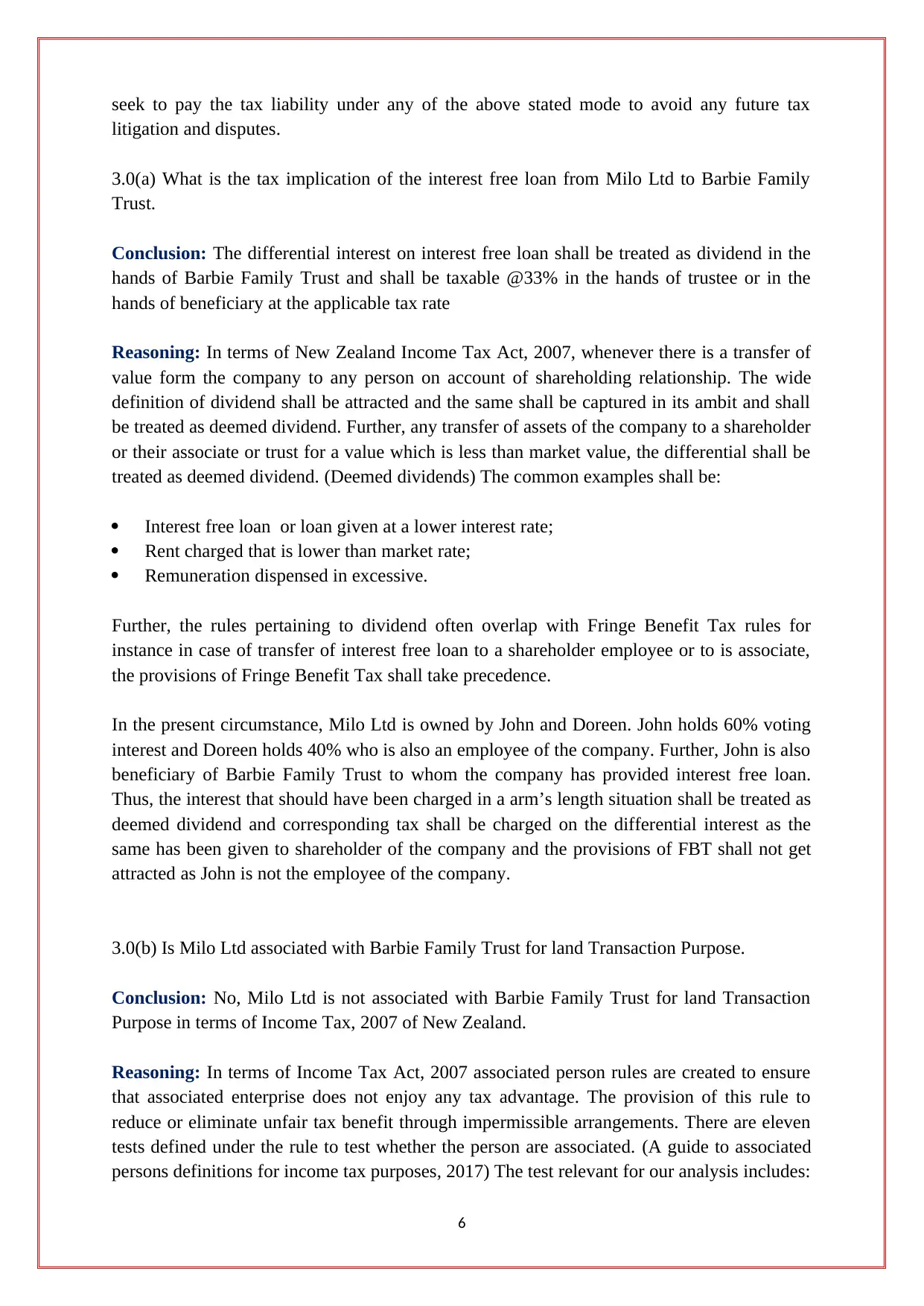
seek to pay the tax liability under any of the above stated mode to avoid any future tax
litigation and disputes.
3.0(a) What is the tax implication of the interest free loan from Milo Ltd to Barbie Family
Trust.
Conclusion: The differential interest on interest free loan shall be treated as dividend in the
hands of Barbie Family Trust and shall be taxable @33% in the hands of trustee or in the
hands of beneficiary at the applicable tax rate
Reasoning: In terms of New Zealand Income Tax Act, 2007, whenever there is a transfer of
value form the company to any person on account of shareholding relationship. The wide
definition of dividend shall be attracted and the same shall be captured in its ambit and shall
be treated as deemed dividend. Further, any transfer of assets of the company to a shareholder
or their associate or trust for a value which is less than market value, the differential shall be
treated as deemed dividend. (Deemed dividends) The common examples shall be:
Interest free loan or loan given at a lower interest rate;
Rent charged that is lower than market rate;
Remuneration dispensed in excessive.
Further, the rules pertaining to dividend often overlap with Fringe Benefit Tax rules for
instance in case of transfer of interest free loan to a shareholder employee or to is associate,
the provisions of Fringe Benefit Tax shall take precedence.
In the present circumstance, Milo Ltd is owned by John and Doreen. John holds 60% voting
interest and Doreen holds 40% who is also an employee of the company. Further, John is also
beneficiary of Barbie Family Trust to whom the company has provided interest free loan.
Thus, the interest that should have been charged in a arm’s length situation shall be treated as
deemed dividend and corresponding tax shall be charged on the differential interest as the
same has been given to shareholder of the company and the provisions of FBT shall not get
attracted as John is not the employee of the company.
3.0(b) Is Milo Ltd associated with Barbie Family Trust for land Transaction Purpose.
Conclusion: No, Milo Ltd is not associated with Barbie Family Trust for land Transaction
Purpose in terms of Income Tax, 2007 of New Zealand.
Reasoning: In terms of Income Tax Act, 2007 associated person rules are created to ensure
that associated enterprise does not enjoy any tax advantage. The provision of this rule to
reduce or eliminate unfair tax benefit through impermissible arrangements. There are eleven
tests defined under the rule to test whether the person are associated. (A guide to associated
persons definitions for income tax purposes, 2017) The test relevant for our analysis includes:
6
litigation and disputes.
3.0(a) What is the tax implication of the interest free loan from Milo Ltd to Barbie Family
Trust.
Conclusion: The differential interest on interest free loan shall be treated as dividend in the
hands of Barbie Family Trust and shall be taxable @33% in the hands of trustee or in the
hands of beneficiary at the applicable tax rate
Reasoning: In terms of New Zealand Income Tax Act, 2007, whenever there is a transfer of
value form the company to any person on account of shareholding relationship. The wide
definition of dividend shall be attracted and the same shall be captured in its ambit and shall
be treated as deemed dividend. Further, any transfer of assets of the company to a shareholder
or their associate or trust for a value which is less than market value, the differential shall be
treated as deemed dividend. (Deemed dividends) The common examples shall be:
Interest free loan or loan given at a lower interest rate;
Rent charged that is lower than market rate;
Remuneration dispensed in excessive.
Further, the rules pertaining to dividend often overlap with Fringe Benefit Tax rules for
instance in case of transfer of interest free loan to a shareholder employee or to is associate,
the provisions of Fringe Benefit Tax shall take precedence.
In the present circumstance, Milo Ltd is owned by John and Doreen. John holds 60% voting
interest and Doreen holds 40% who is also an employee of the company. Further, John is also
beneficiary of Barbie Family Trust to whom the company has provided interest free loan.
Thus, the interest that should have been charged in a arm’s length situation shall be treated as
deemed dividend and corresponding tax shall be charged on the differential interest as the
same has been given to shareholder of the company and the provisions of FBT shall not get
attracted as John is not the employee of the company.
3.0(b) Is Milo Ltd associated with Barbie Family Trust for land Transaction Purpose.
Conclusion: No, Milo Ltd is not associated with Barbie Family Trust for land Transaction
Purpose in terms of Income Tax, 2007 of New Zealand.
Reasoning: In terms of Income Tax Act, 2007 associated person rules are created to ensure
that associated enterprise does not enjoy any tax advantage. The provision of this rule to
reduce or eliminate unfair tax benefit through impermissible arrangements. There are eleven
tests defined under the rule to test whether the person are associated. (A guide to associated
persons definitions for income tax purposes, 2017) The test relevant for our analysis includes:
6
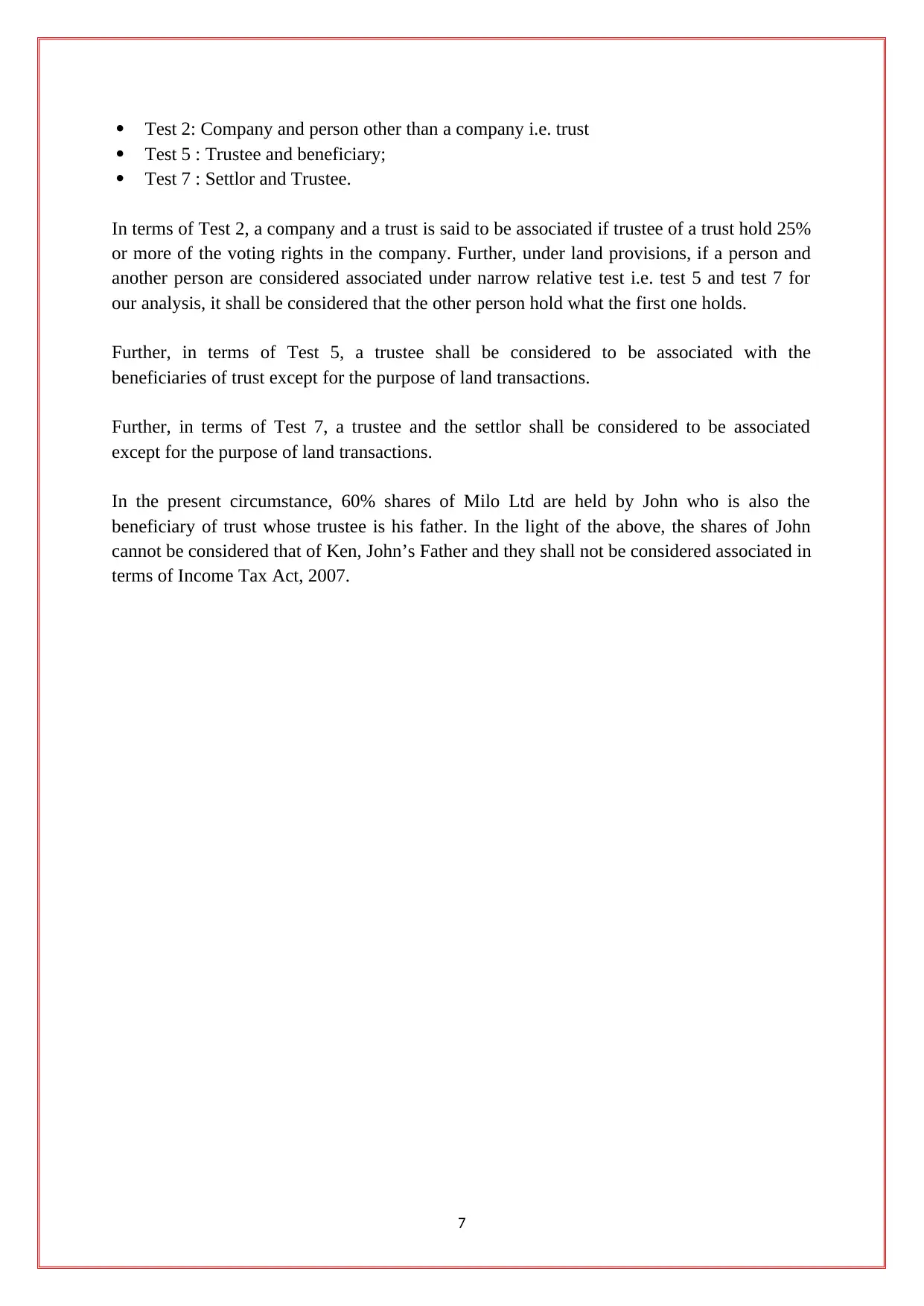
Test 2: Company and person other than a company i.e. trust
Test 5 : Trustee and beneficiary;
Test 7 : Settlor and Trustee.
In terms of Test 2, a company and a trust is said to be associated if trustee of a trust hold 25%
or more of the voting rights in the company. Further, under land provisions, if a person and
another person are considered associated under narrow relative test i.e. test 5 and test 7 for
our analysis, it shall be considered that the other person hold what the first one holds.
Further, in terms of Test 5, a trustee shall be considered to be associated with the
beneficiaries of trust except for the purpose of land transactions.
Further, in terms of Test 7, a trustee and the settlor shall be considered to be associated
except for the purpose of land transactions.
In the present circumstance, 60% shares of Milo Ltd are held by John who is also the
beneficiary of trust whose trustee is his father. In the light of the above, the shares of John
cannot be considered that of Ken, John’s Father and they shall not be considered associated in
terms of Income Tax Act, 2007.
7
Test 5 : Trustee and beneficiary;
Test 7 : Settlor and Trustee.
In terms of Test 2, a company and a trust is said to be associated if trustee of a trust hold 25%
or more of the voting rights in the company. Further, under land provisions, if a person and
another person are considered associated under narrow relative test i.e. test 5 and test 7 for
our analysis, it shall be considered that the other person hold what the first one holds.
Further, in terms of Test 5, a trustee shall be considered to be associated with the
beneficiaries of trust except for the purpose of land transactions.
Further, in terms of Test 7, a trustee and the settlor shall be considered to be associated
except for the purpose of land transactions.
In the present circumstance, 60% shares of Milo Ltd are held by John who is also the
beneficiary of trust whose trustee is his father. In the light of the above, the shares of John
cannot be considered that of Ken, John’s Father and they shall not be considered associated in
terms of Income Tax Act, 2007.
7
Paraphrase This Document
Need a fresh take? Get an instant paraphrase of this document with our AI Paraphraser
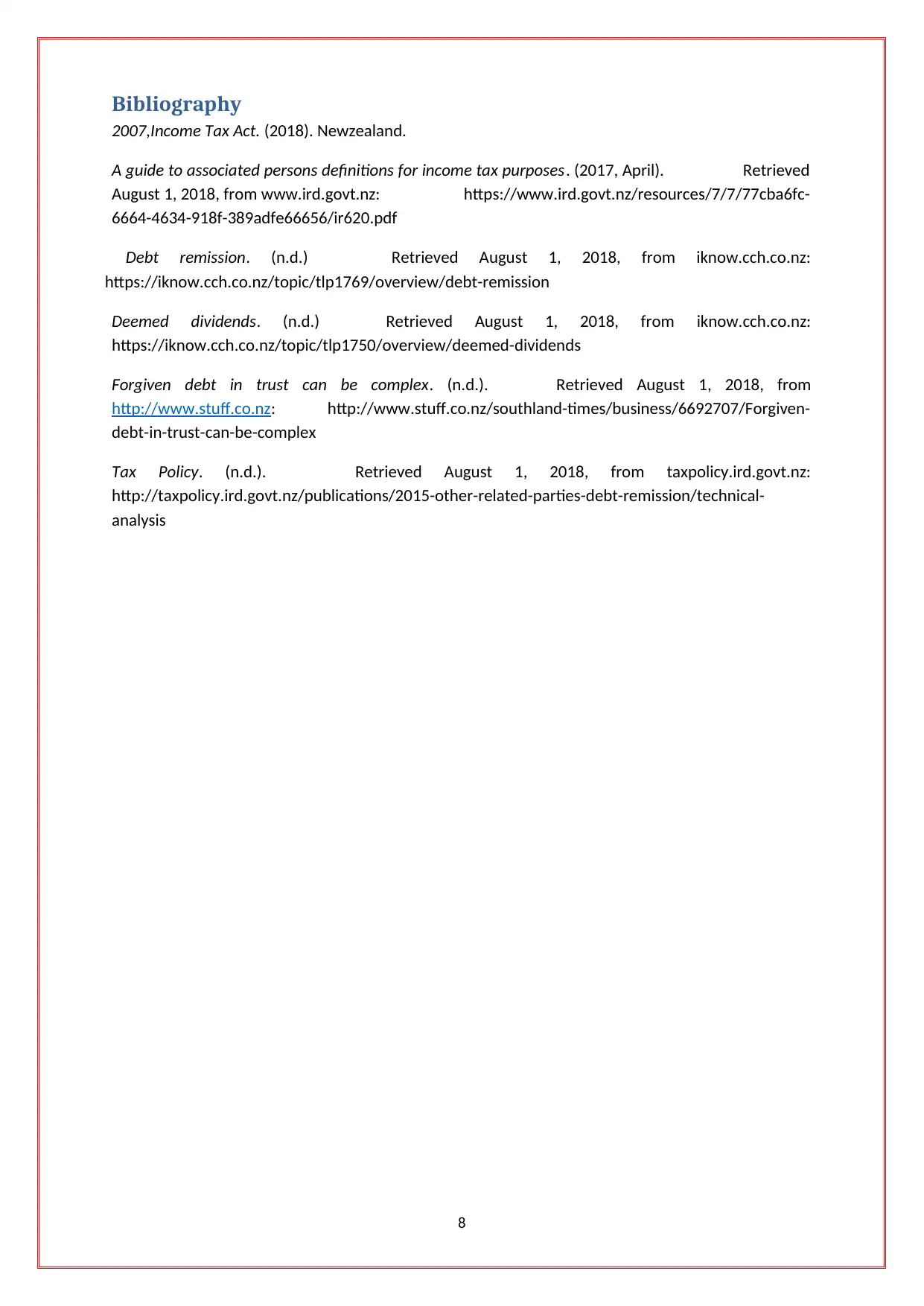
Bibliography
2007,Income Tax Act. (2018). Newzealand.
A guide to associated persons definitions for income tax purposes. (2017, April). Retrieved
August 1, 2018, from www.ird.govt.nz: https://www.ird.govt.nz/resources/7/7/77cba6fc-
6664-4634-918f-389adfe66656/ir620.pdf
Debt remission. (n.d.) Retrieved August 1, 2018, from iknow.cch.co.nz:
https://iknow.cch.co.nz/topic/tlp1769/overview/debt-remission
Deemed dividends. (n.d.) Retrieved August 1, 2018, from iknow.cch.co.nz:
https://iknow.cch.co.nz/topic/tlp1750/overview/deemed-dividends
Forgiven debt in trust can be complex. (n.d.). Retrieved August 1, 2018, from
http://www.stuff.co.nz: http://www.stuff.co.nz/southland-times/business/6692707/Forgiven-
debt-in-trust-can-be-complex
Tax Policy. (n.d.). Retrieved August 1, 2018, from taxpolicy.ird.govt.nz:
http://taxpolicy.ird.govt.nz/publications/2015-other-related-parties-debt-remission/technical-
analysis
8
2007,Income Tax Act. (2018). Newzealand.
A guide to associated persons definitions for income tax purposes. (2017, April). Retrieved
August 1, 2018, from www.ird.govt.nz: https://www.ird.govt.nz/resources/7/7/77cba6fc-
6664-4634-918f-389adfe66656/ir620.pdf
Debt remission. (n.d.) Retrieved August 1, 2018, from iknow.cch.co.nz:
https://iknow.cch.co.nz/topic/tlp1769/overview/debt-remission
Deemed dividends. (n.d.) Retrieved August 1, 2018, from iknow.cch.co.nz:
https://iknow.cch.co.nz/topic/tlp1750/overview/deemed-dividends
Forgiven debt in trust can be complex. (n.d.). Retrieved August 1, 2018, from
http://www.stuff.co.nz: http://www.stuff.co.nz/southland-times/business/6692707/Forgiven-
debt-in-trust-can-be-complex
Tax Policy. (n.d.). Retrieved August 1, 2018, from taxpolicy.ird.govt.nz:
http://taxpolicy.ird.govt.nz/publications/2015-other-related-parties-debt-remission/technical-
analysis
8
1 out of 8
Your All-in-One AI-Powered Toolkit for Academic Success.
+13062052269
info@desklib.com
Available 24*7 on WhatsApp / Email
![[object Object]](/_next/static/media/star-bottom.7253800d.svg)
Unlock your academic potential
© 2024 | Zucol Services PVT LTD | All rights reserved.